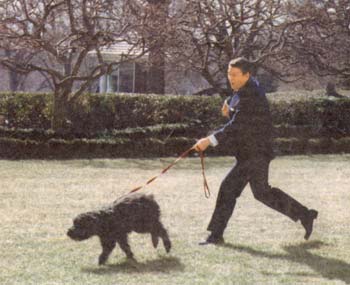 |
Going for a Walkwalking multiple dogs calmly on leashby Pam Green, © 2006, 2008, 2010 |
 |
This might well be the most infamous photograph ever taken of a Bouvier !
Ronald Reagan being dragged accross the White House lawn by his Bouvier puppy "Lucky".
(I considered him even worse as President than he was as dog walker.)
Is this how you want to go for a walk with your dog ? If not, keep reading.
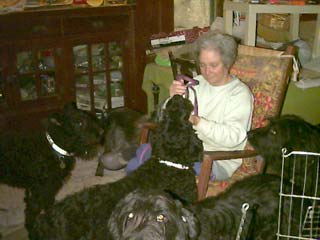 putting leashes on |
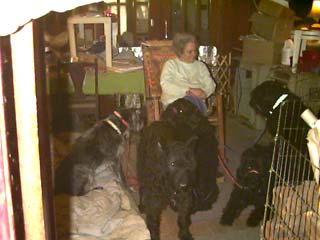 waiting with leashes on |
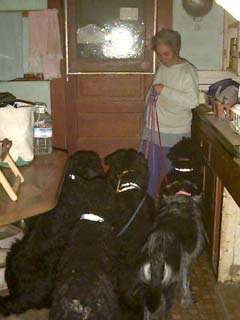 waiting at closed door |
 waiting at open door |
I want all the dogs to be very calm during the leashing up process and to then proceed calmly until we have gone through the route to the exit door and exited that door. I've learned the hard way that when a group of dogs is highly excited and jostling around in a small space, that is a risk situation for a fight to start. I once had a dog injured seriously this way, when he fell and one leg slid under a piece of furniture , the leg getting some torque on it, resulting in a spiral fracture of the radius. Fortunately his leg healed very well after setting and casting, but this is the kind of accident I feel really bad (guilty) about because it should never have happened. Keep your dogs calm during walk preparation and you will have a more enjoyable walk.
As seen in the first photo, I begin my walks by requiring all dogs to be very calm during leashing up. I sit in my rocking chair with leashes in my lap. At first all the dogs are excited, because they are very eager to go for a walk. That is normal and understandable because a walk is one of the most joyful events of their day (car rides and dinner being the other great events), but I require them to calm down.
If they are slow to calm down, I will pick up a book and start reading. My dogs already know (learned on thier own , learning by association without my intentionally teaching them), from long experience, that once I start reading I am likely to continue for some time, thus they might as well calm down. You may find your dogs have learned some different calming signal. If not, then teach them one. A good calming signal, because it calms you as well, is the yoga breathing exercise called "alternate nostril breathing" or you might just sit there breathing in and out very very slowly.
Pixel , with her snout on my chest, is getting leashed first ; she is the pushiest of the dogs and usually thinks she should be first for any privilege and first in my heart. It's probably a good idea to have an order in which you leash up dogs, and that order is likely to reflect the dogs' own ideas and social hierarchy.
Once the leashes are on, I usually wait a bit more while all the dogs remain calm. You can see in the second photo that some of them are sitting or lying down.
Then we proceed to the door leading from my kitchen to the enclosed back porch. With door closed, I require all dogs to be calm. The younger ones are required to sit, while the older and calmer ones may stand. See the third photo
When I open the door, the dogs are required to remain calm as in the fourth photo. Initially you may have to open the door part way then close it as one or another dog gets up or moves foreward. You may have to do this many times. See the article on teaching "Wait" at the door, listed below in Related Topics.
.At the door from the enclosed back porch to the outdoor world, the same rules apply. When I open the door to the outside, I usually step out first , but in any case I require the dogs to just slither out very sedately.
Our walk will then begin with all dogs on leash, all leashes loose. I don't want dogs pulling forward nor hanging back and dragging against my arm. I don't really care if they are walking at one side or the other, a bit in front or somewhat behind, so long as the leashes remain slack. Often they will change positions during the walk. Usually some or most will be walking behind me for some or much of the walk.
Because I live in a rural area surrounded by many acres of row crop land and far from paved roads and far from any livestock that might tempt them, later in the walk those dogs who are sufficiently reliable about keeping within a reasonable distance of me and who are absolutely reliable about coming when called will get to be off leash. The off leash dogs get to run forward then run back to me and they get to examine interesting scents, wade in the creek, and other doggy activities. Thus the more active dogs may cover many times the mileage that I and the on leash dogs cover, thus arriving home properly tired out. One of the goals for a walk is that dogs come home tired enough to want to lie down and rest for a while, but that none come home exhausted or have difficulty in recovering resting rate respiration and heart rate. It's also important that they and I have enjoyed our walk.
These photos were taken in November of 2006. Since then, one of these precious dogs has passed away and another has been adopted. But at the moment, August of 2008, I am still walking 5 dogs together : four of my own and a foster dog. One of mine now rides in a jogger-cart for most of the way, because she is not able to walk very far on her own but she still loves being part of the group and getting to see the sights and smell the breezes.
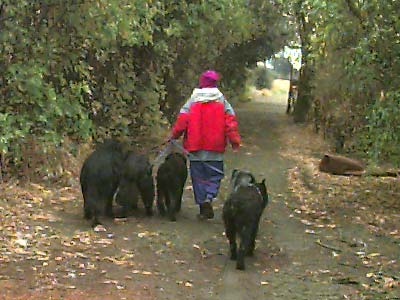 walking down the road, all on loose leashes |
I use head halters on most of the dogs. Most dogs are very comfortable with halters once they are used to them. Most dogs tend naturally to leave the leash loose when walked on a halter, though some will require more training than others to do so. For dogs who tend to lag behind, the halter is more effective than a collar to cue the dog to catch up. For dogs who might "spook" and dodge back from something they encounter on a walk, the halter is safer than a collar because the dog is much less likely to pull back out of the halter and thus be off leash and frightened, a dangerous situation.
While 90% of dogs will easily learn to walk on a loose leash with a halter, a few will tend to pull anyway. For those few, you may find that a pinch collar works far better without needing frequent corrections. My "wicked" little Queensland , Fox, tends to pull mildly on a halter but keeps the leash loose on a pinch collar, needing only an occasional finger strength "tweak" when she does start to get pushy. She also seems much less frustrated on the pinch collar, as indicated by no longer "snout sniping" at dogs next to her.
My goal in dog walk manners is that the dogs keep the leash loose well enough on their own that 95% of the time the leash could be made out of strips of newspaper, ie that the dogs would not pull or lunge or drag behind enough to break a paper leash. Of course the other 5% of the time there could be something that does cause a momentary pull or dart ahead or spook back that would break a paper leash. This paper leash idea is simply an idea that helps me visualize my goal. It's also an old horsemanship school idea, riding with paper reins (but with the ordinary reins also present but dropped to the horse's withers; there in case needed.)
It's advisable to have an individually identifiable leash on each dog. Thus each leash is either a different color or pattern or a different width or different type of material. I can tell which leash is attached to which dog. When you walk multiple dogs, leashes will get tangled. At times it seems like a Maypole dance and can turn into a Gordian Knot if you don't untangle from time to time. You may also want to put somewhat longer leashes on those dogs who you know would rather be at the rear of the group so that they can do so comfortably.
With practice, handling 4 to 6 dogs on leash is easier than driving a four-in-hand of horses.
In any group you may have dogs of different physcial abilities, ages , and/or health, some dogs who want a longer walk or longer and faster and one or more who need a shorter slower walk. That's often the case for me, as I often have an elderly dog or one in poor health. The answer is to plan a double walk. I start out with everyone and take a shorter slower walk, designed for the least physically able dog or dogs, then return to the house and put those dogs inside. The the rest of us head out again and go for a longer walk, maybe at a brisker pace.
Of course during this article I've been talking about dogs who get along together well enough. If you have dogs who really don't get along, then you have to have two or more entirely separate groups for entirely separate walks. Nothing spoils a walk so much as a fight or even having to be vigilant to prevent a fight. New foster dogs often start out living their first few days in a kennel run. The new dog might get solo walks at first, which are actually training sessions in "sit" , "down", and "come" interspersed throughout the walk, before I start introducing that dog to my others. Often I will start by walking the new dog on leash while a dog of opposite sex and good canine social skills comes along off leash. The next day the new dog gets introduced to another dog. If all goes well, within a week the new dog is able to join group walks on leash.
This article is really about walking multiple dogs on leash. That's what most people want or need to do. Most simply do NOT have an area that is really safe for off leash walks even if the dogs are extremely well trained and reliably responsive, and most don't have dogs that are sufficiently reliably responsive to be off leash even in a safe area.
Even when you are going to have part of the walk be off leash for one or more of the dogs, I think it's good to start the walk on leash with dogs very calm and responsive. That sets a good tone. Also that way you have brought the leashes with you and will have them available to re-leash dogs any time there is reason to do so, for example another dog and walker appear or a bicyclist or whatever. Doing the last part going home on leash may also mean a more orderly re-entry to your home.
There's a companion article, Walking Dogs Off Leash This includes teaching dogs a good off leash recall (though I have really done that in two articles on training the recall that are in the Training section (see below in the Related Topics links). I also describe teaching dogs to check in with you and to keep themselves within range of you.
Additional topics related to on leash walks would be the use of "Get Back" training for dogs whose desire to walk faster or to walk ahead of you causes them to tend to pull. Teaching "get back" is related to teaching "move" (move out of my way) which is a valuable safety cue. I haven't written these yet.
Alas, out of the 5 pictured above, only one remains now 4 years later. The largest dog, Nemo , a foster dog, was adopted, which is a happy reason to no longer be in my home. My gracious foster dog, Hazel , passed away with cancer and heartworm damage (acquired under her previous owner) after a year and a half of good quality life with me. My precious Pixel, who can be seen in the Jogger Cart article, passed away at age 13 1/2 from sudden heart failure after living well for 8 months with lymphoma. My darling little Chris, the one with the white sprinkles and the white under his tail, passed away at age 15 from a heart base tumor, having been fortunate enough to have had a liver tumor detected and surgically cured a year and a half earlier. The remaining dog, Shady, half Bouv half Golden, is now at least 14 remains in surprisingly good health and is still able to enjoy walks of 2 or 3 miles.
At the moment I am walking 6 dogs. Two are fosters. Lacy (Bouvier, grey), who is young and very energetic, and Walter (small bouvier, black) is very old and right now can enjoy only a short walk . I am trying to build up the old guy's physical fitness for longer walks, but he has a heart murmur, so I may wind up teaching him to ride in the jogger cart for part of the way. . Three others came to me as fosters, but have remained permanently : Grover (Bouvier, fawn), Velvet (Bouvier, black), and Fox (wicked little Queensland with a personality a lot like Pixel's). And Shady is still here.
Update, after a month of shorter walks, Walter can now enjoy a two mile walk. His enthusiasm has been enhanced by getting a few food treats during the walk. He now goes to the door and bounces and barks when he sees me start to leash dogs up, whereas a month ago he would get himself out of the way and get himself left home if he could.
New photos, current dogs :
7/15/2010 : a friend was here and took some photos. The dogs are ahead of me rather than along side or behind because they are interested in my photographer and the dog (a former foster, thus known to 4 of the 6) at his side. The dogs are (left to right in the shaded photo) Velvet (black Bouv), Lacy (grey Bouv), Fox (red Queensland Heeler or Queensland x Basenji), old man Shady, Grover (beige Bouv), and Walter (small shorn dark grey or black Bouvier)
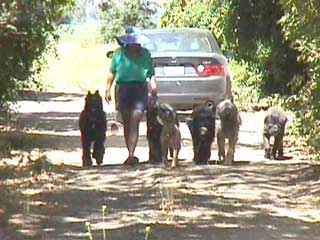 six dogs, my shaded exit drive
six dogs, my shaded exit drive |
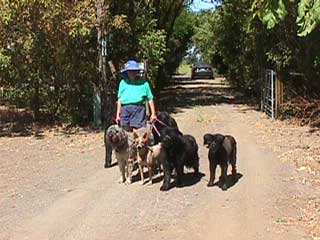 six dogs, eager to go
six dogs, eager to go |
And remember that a walk is as much for the enjoyment of your dogs as it is for your own enjoyment.
The joyful dog, although she cannot talk,
Shares with her human the pleasures of the walk.
| SITE INDEX | BOUVIER | RESCUE | DOG CARE |
| PUPPY REARING | TRAINING | PROBLEMS | WORKING DOGS |
| BOOKS | VERSE | IMAGES | MISCELLANEOUS |
| site author Pam Green | copyright 2003 |
| created 8/20/08 | revised 8/24/2010, 7/04/2020 |
| return to top of page | return to Site Index |